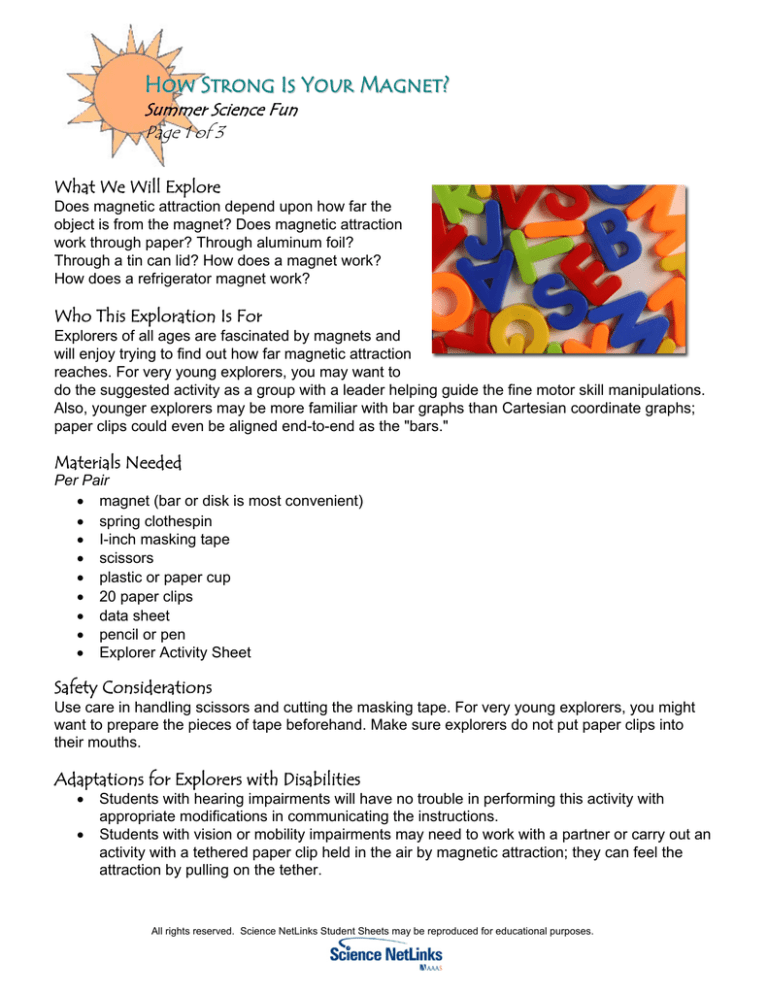
How Strong Is Your Magnet?
Summer Science Fun
Page 1 of 3
What We Will Explore
Does magnetic attraction depend upon how far the
object is from the magnet? Does magnetic attraction
work through paper? Through aluminum foil?
Through a tin can lid? How does a magnet work?
How does a refrigerator magnet work?
Who This Exploration Is For
Explorers of all ages are fascinated by magnets and
will enjoy trying to find out how far magnetic attraction
reaches. For very young explorers, you may want to
do the suggested activity as a group with a leader helping guide the fine motor skill manipulations.
Also, younger explorers may be more familiar with bar graphs than Cartesian coordinate graphs;
paper clips could even be aligned end-to-end as the "bars."
Materials Needed
Per Pair
• magnet (bar or disk is most convenient)
• spring clothespin
• I-inch masking tape
• scissors
• plastic or paper cup
• 20 paper clips
• data sheet
• pencil or pen
• Explorer Activity Sheet
Safety Considerations
Use care in handling scissors and cutting the masking tape. For very young explorers, you might
want to prepare the pieces of tape beforehand. Make sure explorers do not put paper clips into
their mouths.
Adaptations for Explorers with Disabilities
•
•
Students with hearing impairments will have no trouble in performing this activity with
appropriate modifications in communicating the instructions.
Students with vision or mobility impairments may need to work with a partner or carry out an
activity with a tethered paper clip held in the air by magnetic attraction; they can feel the
attraction by pulling on the tether.
All rights reserved. Science NetLinks Student Sheets may be reproduced for educational purposes.
How Strong Is Your Magnet?
Summer Science Fun
Page 2 of 3
Curiosity Starter
Have available various kinds of magnets, several objects that are attracted to a magnet (tacks,
pins, paper clips, "tin" cans, etc.), and a small compass. Begin with some brainstorming (and
experimenting) around questions like these: What kinds of objects are attracted to a magnet? What
objects does a magnet stick to? Do all the things that are attracted to a magnet share the same
properties? How does a compass work? What attracts the compass?
What to Do
Materials Preparation
• Make copies of the Explorer Activity Sheet and Data Sheet for each child or pair of children.
• Make a large graph on newsprint paper or the chalkboard. If the magnets are all the same
(or supposed to be), average the students' findings and graph the class findings. If the
magnets are different, use a different symbol for each group to show the results "separated"
but on the same plot. The x-axis (horizontal) is for the distance from the magnet (that is, the
number of layers of tape beginning with zero—this is the variable you can control); the yaxis (vertical) is for the strength of the attraction (number of paper clips it can hold—this is
the result that may depend on the distance from the magnet).
Guiding the Exploration
(See also the questions throughout the Activity Sheet.)
• Are all magnets the same strength?
• Will a magnet work when it isn't actually touching a piece of metal?
• How many paper clips can the magnet hold without any masking tape?
• As you begin adding layers of tape, what happens? Why?
• Is the masking tape a magnet? How do you know? If not, why are the paper clips attracted
to it?
• What happens to the attraction of the paper clip(s) to the magnet as you add more layers of
tape? Why?
• What does the graph tell us?
• Is the magnetic attraction blocked by the tape, or is it just the added distance between the
magnet and the paper clip that causes decreased attraction? Can you think of an
experiment to do to test your answer? Try it.
Where to Go from Here
•
•
Instead of tape, try materials of different thicknesses and compositions, such as cardboard
or construction paper, to see how a magnet's force can be affected.
An applications engineer figures out ways to apply technology to practical uses, such as
using a very strong magnet to lift and move wrecked cars in a junkyard.
All rights reserved. Science NetLinks Student Sheets may be reproduced for educational purposes.
How Strong Is Your Magnet?
Summer Science Fun
Page 3 of 3
Why It Happens
A magnetic field (the pull of the magnet) will pass through materials such as tape with almost no
effect. The tape does not block the attraction of the magnet for the paper clip. Rather, each piece
of tape removes the paper clip from the surface of the magnet by one more small increment of
distance, equal to the thickness of the tape. The tape is just a convenient way to move the clip and
the magnet apart bit by bit.
The distance between the magnet and the clips, not the tape itself, lessens the attraction of the
magnet. We can also describe this in terms of the magnetic field: As you move farther from the
magnet's pole, the field becomes weaker and weaker.
You can show that the strength of the magnetic field decreases the farther you move from the
magnet by a simple demonstration. Tie one end of a thread to a paper clip and tape the other end
to the surface of a table. Hold a magnet above the paper clip. You can hold the clip up in the air
(and keep the string taut) as long as the magnet is fairly close to the paper clip. If you move the
magnet too far away from the clip, the strength of the magnetic field decreases, and the paper clip
falls.
All rights reserved. Science NetLinks Student Sheets may be reproduced for educational purposes.

